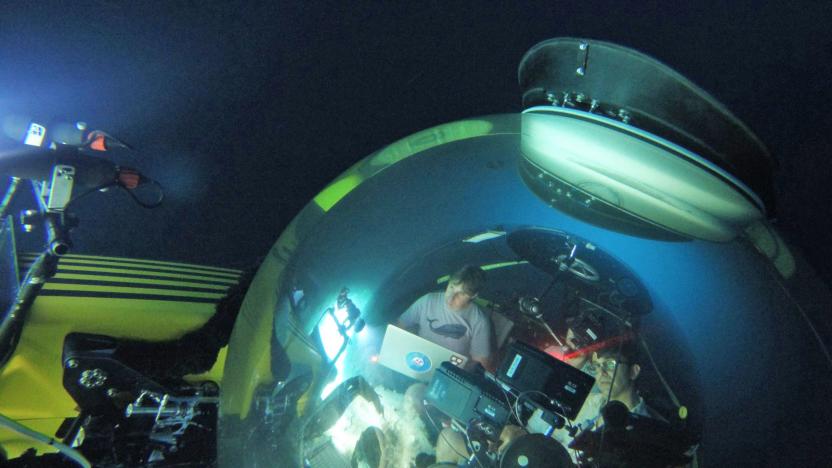submarine
Latest

Hitting the Books: What astronauts can learn from nuclear submariners
In his latest book, Spacefarers: How Humans Will Settle the Moon, Mars, and Beyond, Christopher Wanjek examines humanity’s obsession with space travel, why our dreams of living among the stars haven’t yet come to fruition and what it will take to finally get our interstellar efforts off the ground. Excerpted from SPACEFARERS: HOW HUMANS WILL SETTLE THE MOON, MARS, AND BEYOND by Christopher Wanjek, published by Harvard University Press. As hostile an environment as Antarctica is, the icy continent still has one thing that the Moon and Mars doesn’t, and that’s air.
Andrew Tarantola07.11.2020
Google’s Curie undersea cable now connects the US and Chile
Curie, a 10,500-kilometer-long undersea cable, now connects Google data centers in the US and Chile. Today, Google announced that the fiber optic cable has been successfully installed and tested. It is expected to begin transmitting data in the second quarter of 2020, and Google is already working on a branch into Panama.
Christine Fisher11.14.2019
Glove-controlled robot arm is soft enough to pet jellyfish
Remote-controlled robot arms allow submersible operators to perform tasks underwater. But can you imagine a rigid metal limb interacting with something as fragile as jellyfish or corals? To be able to capture or interact with marine life, scientists need something softer that can touch delicate living things without squishing them to death. That's why a team of scientists from Harvard's Wyss Institute has developed a soft robotic arm that can "move with unprecedented dexterity to grasp and sample delicate aquatic life."
Mariella Moon10.03.2018
MIT finds a way for submarines to talk directly to airplanes
Submarines can't normally communicate directly with anything above the water due to the physical limits of their signal, but that might change in the near future. Researchers have developed a wireless system that can transmit data from an underwater source to the air. The approach, known as translational acoustic-RF communication (TARF), sends a sonar signal to the surface, where tiny vibrations at different frequencies correspond to the 0s and 1s of binary data. Above the water, an extremely high frequency radar (30GHz to 300GHz) can pick up on minuscule changes in signal angles that relate to the data bits. It's just a matter of processing the bits into meaningful data after that.
Jon Fingas08.21.2018
Elon Musk's mini-sub was 'not practical' for Thailand cave rescue
The Thai cave rescue is over, with all 12 boys and their coach safely above ground. Elon Musk's miniature submarine clearly arrived too late. However, it's now clear that it wouldn't have seen use regardless. In the last few hours of the operation, joint command center lead Narongsak Ostanakorn told Musk that his tech was "good and sophisticated," but that it was "not practical" for the rescue. While officials haven't provided detailed reasoning, a look at the logistics of the rescue might explain why.
Jon Fingas07.10.2018
Elon Musk's Thailand cave rescue would use a 'kid-size' submarine
Elon Musk is quickly solidifying his offer to help rescue a boys' soccer team trapped in a Thailand cave, and in just the way you would expect from a technology entrepreneur. He has revealed that the "primary path" for his attempt will involve a "kid-size submarine" that uses the liquid oxygen transfer tube of a SpaceX Falcon 9 rocket as its hull. He added that it be "extremely robust" and would support many as four air tanks, with four handles that could be used as hitching points for ropes and cables.
Jon Fingas07.07.2018
Chinese hackers stole undersea warfare data from US Navy contractor
Hackers associated with the Chinese government have broken into a US Navy contractor's systems and stolen data about undersea warfare. According to The Washington Post, these include secret plans to create a new anti-ship missile usable on US submarines by 2020.
David Lumb06.09.2018
US Navy will use Xbox controllers to steer submarine periscopes
The Pentagon might have to buy Xbox controllers en masse in the future if the military ends up using them to control its laser weapons and other equipment. In fact, the US Navy will begin stocking its modernized Virginia-class submarines with them, starting with the USS Colorado that's expected to be commissioned in November. Sailors aboard the high-tech submarine will use the Xbox controller to maneuver its periscope. See, unlike periscopes in movies, wherein a single person has to peer through an eyepiece, the high-tech version of the instrument uses high-resolution cameras and displays images on big screens.
Mariella Moon09.19.2017
DARPA is building acoustic GPS for submarines and UUVs
For all the benefits that the Global Positioning System provides to landlubbers and surface ships, GPS signals can't penetrate seawater and therefore can't be used by oceangoing vehicles like submarines or UUVs. That's why DARPA is creating an acoustic navigation system, dubbed POSYDON (Positioning System for Deep Ocean Navigation), and has awarded the Draper group with its development contract.
Andrew Tarantola05.10.2016
ICYMI: Spacey HoloLens use, spy submarines and more
#fivemin-widget-blogsmith-image-905675{display:none;} .cke_show_borders #fivemin-widget-blogsmith-image-905675, #postcontentcontainer #fivemin-widget-blogsmith-image-905675{width:570px;display:block;} try{document.getElementById("fivemin-widget-blogsmith-image-905675").style.display="none";}catch(e){}Today on In Case You Missed It: DARPA is about to start testing an autonomous submarine called Sea Hunter, designed to find and trail larger submarines for weeks at a time.
Kerry Davis02.16.2016
Deep-ocean diving robot Nereus is gone and won't be replaced
Last year, the only robot capable of diving into and exploring the deepest ocean trenches (the hadal zone) perished on the job, and now its creators have announced that it will not be replaced. That robot was called Nereus: a hybrid ROV that could either operate autonomously or be controlled remotely by scientists, built by the Woods Hole Oceanographic Institution. It was unique, because it could move and explore hadal zones (parts of the ocean 20,000 feet and below) freely, while the other robots called landers that can reach those depths are designed to sink to the bottom to collect data until they're retrieved. Unfortunately, Nereus imploded in the Pacific Ocean in 2014 due to unknown reasons -- after all, there's no other robot capable of looking for its debris.
Mariella Moon12.09.2015
Scientists build atom-scale sub that moves at 'breakneck' speeds
There are still no nanobots plying our bloodstreams, seeking and destroying cancer and other diseases. However, scientists at Rice University have just built a molecule-scale "submarine," so that's a pretty positive step towards "Fantastic Voyage." Mades at the same lab that developed "nanocars," the devices are a mere 244 atoms in size, with motors powered by ultraviolet light that turn at over a million RPM. That propels them along at a solid one inch per second, which is a "breakneck" pace according to lab director James Tour. "These are the fastest-moving molecules ever seen in solution," he said.
Steve Dent11.18.2015
Robotic bees outdo their organic rivals by swimming
Harvard's Robobees are already pretty adroit for paper-clip sized drones; they fly around stably in calm air and hover like real bees (if real bees were tethered to power). Researchers have given them a new talent that even the insects don't have -- the ability to "fly" underwater. To do so, they make like ducks and transition from flight to swimming by crashing into the water, sinking a bit, then flapping their wings at a slower pace (9 Hz) than in the air (120 Hz) . That's already a feat that few drones can match, but the aim is to eventually build autonomous bots that could do search and rescue and other beneficial activities.
Steve Dent10.05.2015
Duck-like US Navy drone can fly or swim to hunt submarines
There are plenty of flying and swimming drones, but you'd ideally have both at once for sub-hunting -- you want something that can poke its head underwater, but move quickly through the air when needed. The US Navy certainly knows this. It's developing a duck-like drone, the Flimmer, that can both fly and swim. In addition to both a rear-facing propeller and wings, its latest incarnation has four fins that adapt to what the robotic craft is doing. In flight, they serve as stabilizers and canard wings; in the sea, they flap to give the machine a speed boost.
Jon Fingas04.01.2015
Watch how a NASA sub could explore Titan's biggest methane sea
NASA has long announced that it wants to create a tough-as-nails submarine that can withstand extreme conditions, because it's going to explore the largest liquid methane/ethane sea on Saturn's biggest moon Titan. Now, the agency has released a concept video of the robotic submersible and also revealed more details about the potential mission at this year's Innovative Advanced Concepts (NIAC) Symposium. Despite being a natural satellite, Titan is pretty Earth-like with a dense atmosphere, and the agency likely wants to see if life once existed there or to look for clues on how life on Earth began. NASA envisions sending the unmanned vehicle on a 90-day mission exploring the depths of Titan's largest body of liquid ominously named Kraken Mare, collecting and analyzing samples the whole time.
Mariella Moon02.13.2015
Natural Selection 2 dev's 'Subnautica' dives into Steam Early Access
Natural Selection 2 developer Unknown Worlds launched its latest game on Steam Early Access this week, Subnautica. In it, players submerse themselves in an "alien underwater world" with brightly-colored creatures and environments, such as coral reefs and volcanoes. Fighting to survive, the swimmers also hunt for resources to build new gear and submarines, allowing them to further explore the aquatic areas. Subnautica is currently 10 percent off ($18) until December 23 and supports virtual reality headsets such as Oculus Rift. Unknown Worlds handed development duties for Natural Selection 2 to a group of dedicated fans in June, after announcing Subnautica one year ago. Head past the break to see a trailer for Subnautica, showing some of the pretty (and some of the ferocious) creatures in the Early Access game. [Image: Unknown Worlds]
Mike Suszek12.17.2014
Virgin Oceanic pauses its deep sea exploration plans
If you were hoping to see Virgin Oceanic visit the deepest parts of Earth's oceans, you'll have to put those dreams on hold. The company has confirmed that it's at least temporarily dropping plans to make five dives using its DeepFlight Challenger craft. Virgin isn't saying just what prompted the decision, but founder Sir Richard Branson alluded to a cancellation in August. He stressed the importance of "knowing when to change tack" and that Virgin Oceanic was "widening its focus" to work on more accessible ocean exploration. In short, DeepFlight wasn't panning out.
Jon Fingas12.13.2014
HTC teases action cam launch on October 8th (update: and it looks like this)
Those claims that HTC is making an action camera just got much more concrete. The company has posted both a RECamera teaser site and a video (below) which not-so-subtly hint that the adventure-oriented shooter should launch on October 8th, the same day as HTC's "Double Exposure" media event. While there aren't many giveaways in the clip, it shows both a swimming pool dive and a wide-angle lens -- this is undoubtedly a waterproof device meant to take on the likes of GoPro. There's nothing here to confirm rumors that the camera will have a 16-megapixel sensor and wireless networking, but you'll only have to wait a couple of weeks to get the full scoop. Update: And one enterprising Redditor's found pictures of the device -- which looks like... a... periscope? The image's source has now been taken down. Darn.
Jon Fingas09.24.2014
Supersonic subs look to cross the Pacific in under two hours
The distance between Shanghai and San Francisco is around 6,135 miles (9,873 km), and a team of scientists aims to make that trip possible in 100 minutes. Researchers at Harbin Institute of Technology's Complex Flow and Heat Transfer Lab have developed new tech that allows submarines to traveling a crazy-high speeds beneath the water. The solution? Create an air "bubble" of sorts that leverages supercavitation, a technology applied to torpedoes, to reduce drag caused by water while in route. Theoretically, this means that the vehicles could reach the speed of sound underwater (around 5,800km/h or 3,694 MPH while submerged), reducing the travel time between the aforementioned cities to under two hours.
Billy Steele08.26.2014
Japan's developing an eco-friendly patrol submarine
These days, data centers, portable USB battery chargers and all sorts of transportation are going green thanks to fuel cell technology. Now you can add submersibles to that list: Japan is developing a 33-foot-long submarine that runs off emissions-free energy. Japanese Defense Ministry officials told AFP that the finalized tech is about five years out, but they estimate the $25 million unmanned sub (or UUV) will be capable of cruising deep waters for an entire month on a single charge. Sure, 30 days seems pale in comparison to the 50-year core life of the nuclear-powered USS Nautilus, but electro-chemical energy is far cleaner, and can be much cheaper in the long run. This driverless U-boat also won't have any artillery on board. According to a ministry official, "The UUV is purely for patrolling -- it's not a military weapon," so there's no need to worry about underwater combat drones -- at least, for now.
Andy Bowen08.08.2014